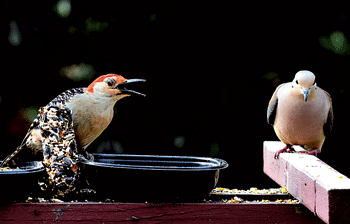BIRDS AS WINNERS AND LOSERS
 The wild turkey, read in a recent magazine article, is a winner. A winner among birds was described in the article as a bird that has increased in number, or is increasing or both. The wild turkey has certainly done that. Once it was found in limited numbers in only a few places. Now wild turkeys are common, though not abundant, in the eastern two-thirds of the U.S. and in southern Canada wherever there are woods.
The wild turkey, read in a recent magazine article, is a winner. A winner among birds was described in the article as a bird that has increased in number, or is increasing or both. The wild turkey has certainly done that. Once it was found in limited numbers in only a few places. Now wild turkeys are common, though not abundant, in the eastern two-thirds of the U.S. and in southern Canada wherever there are woods.
The Canada goose is another winner, perhaps the biggest winner. It’s more numerous and has a broader range than the wild turkey. The bald eagle is a winner and the osprey, the peregrine falcon, sandhill crane, wood duck and eastern bluebird.
If birds that are now more numerous than they were, are winners, birds that are less numerous are losers. The eastern meadowlark is a loser. Once one of the most common birds of open fields, it is now gone from many areas where it was common. The bobolink is another loser and the vesper sparrow, Savannah sparrow, dickcissel, red-headed woodpecker, nighthawk, chimney swift and rusty blackbird.
Note, most of the birds I listed as winners have benefited from people doing things to increase their distribution. Wild turkeys, for example, were trapped, transported to areas where they did not exist that were considered appropriate habitat, often places where they had nested previously, and released. I was present at a release of wild turkeys in Indiana. Those turkeys had been trapped in Iowa.
Nestlings of bald eagles were taken from nests, put in artificial nests in locations where they had nested but didn’t any longer, fed in those nests and allowed to fly free when they were able. Nesting platforms big enough for ospreys were put on poles in places where ospreys were sometimes seen but did not nest.
Eggs were taken from the nests of Canada geese, hatched in incubators, then the goslings were released at different lakes and wetlands when they were old enough to live free on their own. Peregrine falcons were taken from the wild, raised in captivity then released in areas where they had nested before. They were also released in cities where those that became adapted and mated nested on ledges of buildings and under bridges. For some years now a pair of peregrine falcons has nested in Indianapolis, another in Fort Wayne.
Wood ducks once nested almost exclusively in hollows in trees. Clearing around lakes and along rivers destroyed their nest sites. But then people began making and putting out nest boxes suitable for wood ducks and since then wood ducks have increased until they are common over much of their former range.
Eastern bluebirds also benefited from construction and placement of nest boxes. People established bluebird nest box trails, nest boxes at intervals, then checked those boxes periodically, repairing them when necessary and removing the nests of house sparrows.
All the birds I’ve listed as winners were once losers and they were losers because of the activities of people. Wild turkeys were over hunted. Canada geese were over hunted and wetlands where they nested were drained. Eagles and ospreys were shot, the ospreys because they were believed to be detrimental to fishing. Peregrine falcons were shot and young were taken from nests to be trained for falconry. Eagles and peregrines also declined because of egg shell thinning when DDT was used extensively.
People have been and are responsible for birds becoming winners and losers. Habitat alteration, forest clearing, drainage, converting grasslands to farmed fields are major factors. Many losers are grassland birds. Corn and soybeans are not satisfactory substitutes for prairie. Pollution is another factor, pollution of the soil and of the air. Now there is climate change making some birds winners, others losers.
- Birds As Weather Forecasters – Life In The Outdoors - December 17, 2021
- Rare Bird Spotted In Indiana – Life In The Outdoors - October 8, 2021
- MY EXPERIENCE WITH DEER – Life In The Outdoors - July 30, 2021


